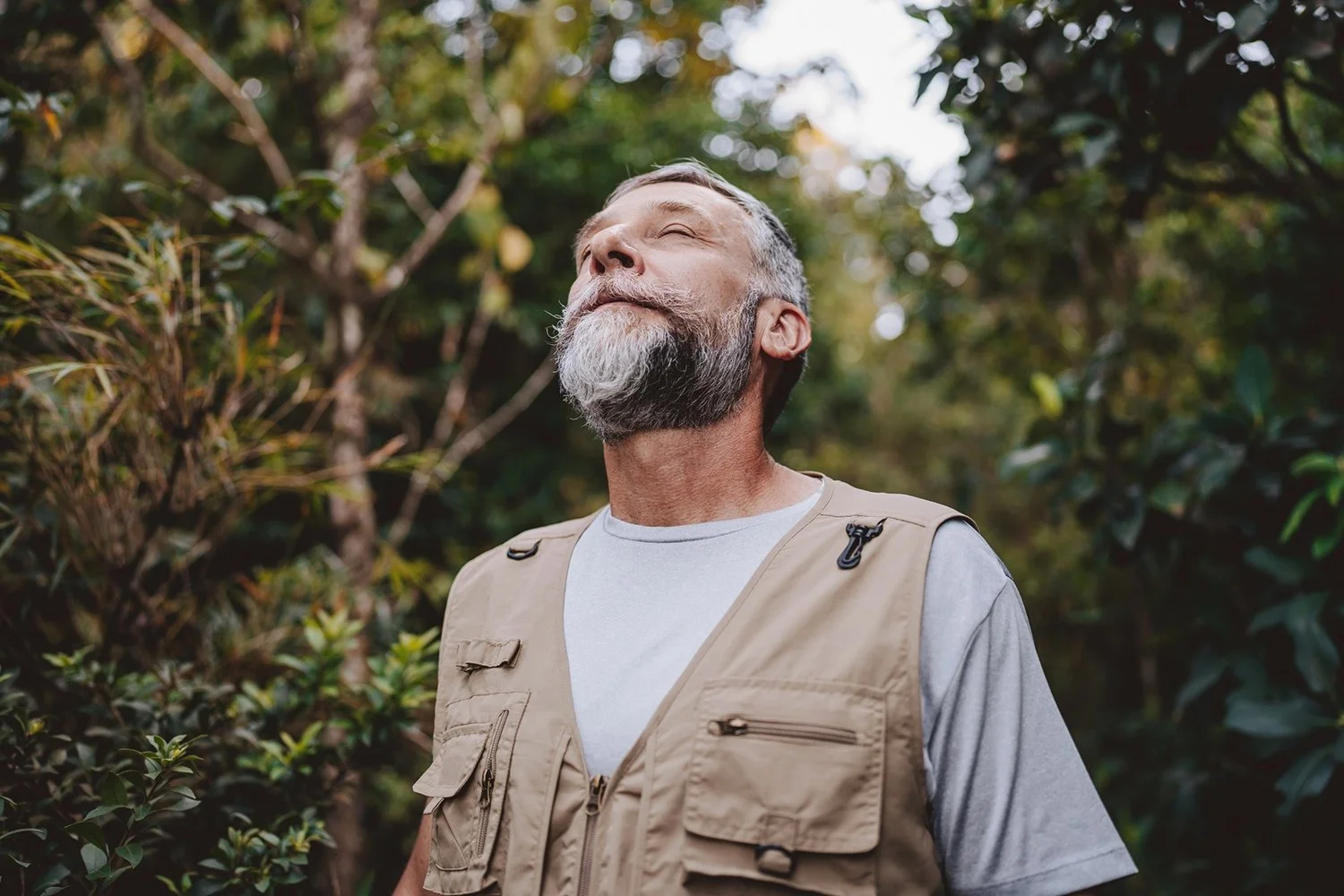10 relaxation techniques that can help lower high blood pressure

Clinically reviewed by Dr. Chris Mosunic, PhD, RD, MBA
Taking time to relax can do more than cut down your stress. Learn 10 relaxation techniques that may help to lower your blood pressure, and the science behind why it helps.
If you’ve recently been told your blood pressure is too high, you might be feeling a mix of confusion, worry, and guilt. Maybe the numbers caught you off guard, or you’ve known that your blood pressure has been creeping up, but haven’t had the bandwidth to deal with it. And now you’re googling “how to lower blood pressure naturally,” trying to make sense of it all.
One big piece of the blood pressure puzzle is stress. Not just stress caused by life-changing circumstances, but that simmering low-level pressure that builds when you’re holding everything together. From work commutes and deadlines to financial strain and caregiving responsibilities, our nervous systems rarely get a proper break. And that ongoing activation can keep your blood vessels tight and your heart working harder than it needs to.
The good news is that there are gentle, research-supported ways to help your body relax, and many of them you can start today. You don’t need to overhaul your life or have a perfect meditation practice to begin seeing benefits (although meditation can help). You just need a few techniques that are easy to do and grounded in how stress physiology actually works.
Why stress impacts blood pressure
While you might notice stress first in your mind, it affects the body, too. Your brain triggers a series of physiological reactions when you’re stressed, and over time, this can then lead to elevated blood pressure. Here are some ways stress impacts the body:
Your brain detects a threat, whether real or perceived: When a stressor comes into your life, like a financial deadline or a tough conversation, your brain responds by activating your sympathetic nervous system.
Stress hormones flood your system: Chemicals like cortisol and adrenaline are released, which cause your heart to beat faster and your blood vessels to constrict. This temporarily increases blood pressure, which is helpful in an emergency, but not so helpful if it’s happening all the time.
Your body stays stuck in “go” mode: Chronic stress means constant activation. As a result, the elasticity of your blood vessels can wear down and put extra strain on your heart, causing high blood pressure.
Even healthy habits can get outpaced by stress: If stress goes unmanaged, it can undercut your healthy eating habits and even your blood pressure medication.
The science behind why relaxation can help
Relaxation gives your body opportunities to shift into a state where healing, digestion, and recovery can happen more easily.
This shift is guided by your parasympathetic nervous system, which is the counterpart to the fight-or-flight response. When this is activated, it slows your heart rate, relaxes your blood vessels, and promotes a feeling of safety. Over time, these changes can help reduce baseline blood pressure and ease strain on the cardiovascular system.
Some relaxation techniques that can help your body come down from stress include taking a few deep breaths, practicing a quiet visualization, or stretching between meetings. But it’s important to note that these methods alone can’t replace medical treatment.
How to lower blood pressure with relaxation techniques: 10 tips
What calms you in one moment might not land the same in another. That’s why it can help to have a handful of techniques you can rotate through, depending on your mood and time constraints.
Here are 10 different relaxing methods that may help lower blood pressure.
1. Try belly breathing for 5 minutes a day
Sit or lie down somewhere comfortable, place one hand on your belly and one on your chest, and then inhale slowly through your nose for about four seconds. Your belly should rise. Then exhale gently through your mouth for six seconds. Repeat this for several minutes.
Why it works: Longer exhales help engage your body’s relaxation response.
Try this: Stack it onto an existing routine, like right after a bathroom break at work.
Related read: 7 deep breathing exercises to help you calm anxiety
2. Practice progressive muscle relaxation (PMR)
Tense and relax different muscle groups in your body one by one. Start at your toes and work your way up to your face. Inhale and tense one area for five seconds. Then exhale and release for 10 seconds.
Why it works: It brings attention to where you’re holding tension, and it teaches your body how to let go of it.
Try this: Use a guided meditation for PMR if you don’t want to think through the steps on your own.
3. Use guided imagery or visualization
Imagine yourself somewhere peaceful, like floating in water or lying under a tree. For an added boost, try to picture the sensory details, like what you see, hear, and smell.
Why it works: The brain often responds to imagined calm the same way it does to real-life calm.
Try this: Guided meditations and short videos can walk you through this process in 3–5 minutes and take some of the heavy lifting off your plate.
Read more: Visualization meditation: 8 exercises to add to your practice
4. Meditate for a few minutes
When you have a free moment, focus on a single word, your breath, or even a sound for a couple of minutes. You can do this sitting down, in your car, or wherever feels good to you. Then, set a goal to practice returning your attention to the present moment again and again.
Why it works: Regular meditation is linked to lower resting blood pressure and reduced cortisol levels.
Try this: Start with a one-minute timer and work your way up from there.
💙 Try a short and sweet meditation like this One-Minute Reset with Chibs Okereke.
5. Explore gentle movement
Practices like tai chi, yoga, stretching, or even a slow walk can all support blood flow, reduce muscle tension, and pair well with mindful breathing. Try doing just one of these for 10 minutes once a day.
Why it works: Movement can help metabolize stress hormones. It also physically grounds you in the moment.
Try this: Don’t get hung up on having the perfect form. Instead, focus on moving in a way that feels good and intentional.
Read more: 7 simple movement exercises to boost your mental health
6. Try a warm bath or shower
Immersing your body in warm water can increase circulation and temporarily help reduce blood pressure. It can also be a way to signal to your body that it’s safe to relax.
Why it works: Warmth dilates blood vessels and helps to soothe your nervous system.
Try this: Add dim lighting and lavender-scented soap if it helps set the tone.
7. Listen to calming music
Slow, instrumental music, especially with a tempo of around 60–80 beats per minute, can have a measurable effect on heart rate and blood pressure. Nature sounds can also work well.
Why it works: Your body often mirrors the rhythm of the music you’re hearing.
Try this: Keep a calming playlist saved on your phone for easy access when you feel stressed.
💙 Awaken your innate connection to nature by listening to the Botanical Sound Bath playlist.
8. Practice the 4–7–8 breathing technique
Inhale through your nose for four counts, hold your breath for seven, and then exhale through your mouth for eight. This can reduce anxiety and promote relaxation.
Why it works: The extended exhale helps activate your parasympathetic nervous system.
Try this: Do 3–4 rounds before bed or before a stressful doctor’s appointment.
9. Use the S.T.O.P. technique during stressful moments
Stop what you’re doing. Take a breath. Observe what you’re feeling physically, emotionally, and mentally. Proceed with intention.
Why it works: It interrupts your automatic stress patterns and helps give your brain a moment to regulate.
Try this: Practice it once a day, even when life doesn’t feel stressful. This can help you build the habit.
10. Build tiny relaxation cues into your routine
Set a calming image as your lock screen or keep a breathing stone in your pocket. Doing little actions like this can help gently nudge yourself back to balance.
Why it works: Regular and small exposures to calm help retrain your body to respond differently to stress.
Try this: Choose one cue you’ll notice and tie it to something you already do, like steeping your morning tea.
Relaxation techniques for high blood pressure FAQs
What are the different types of relaxation techniques for high blood pressure?
Some techniques that can help lower your blood pressure are diaphragmatic breathing, progressive muscle relaxation, and guided visualization. Meditation, yoga, stretching, and listening to calming music can significantly help as well.
All of these practices can help shift your body out of stress mode and into a more restful state.
How often should I use relaxation techniques to see results?
Research suggests that 10-20 minutes a day of relaxation techniques can help lower your blood pressure over time. But there isn’t an exact number for this. In general, it’s about consistency. So, aim to do it regularly as it helps keep things from building up.
You might find it easier to tie a relaxation practice to something you already do, like unwinding before bed. A good rule of thumb is to just start where you are and then build from there.
Can relaxation techniques replace blood pressure medication?
Relaxation practices can support your overall treatment plan, but they’re not a substitute for prescribed medication. If you’re managing high blood pressure, it’s important to stay in touch with your healthcare provider.
With that said, incorporating these practices into your life can improve your daily well-being, and that matters too.
Is meditation good for high blood pressure?
Studies have shown that regular meditation can help lower blood pressure and decrease stress hormones. Mindful walking, guided meditations, and even focusing on your breath for a few minutes can all help.
If you’re interested in practicing meditation to help with your blood pressure, find a style that feels doable to you. This way, you’ll be more likely to return to it regularly.
Do relaxation techniques for high blood pressure work immediately?
Some people feel calmer right away after practicing relaxation techniques. They feel more at ease in their body, and they also experience a slower heart rate.
But in general, meaningful changes typically take time and repetition. These techniques are less about instant results and more about building a balanced nervous system over the long haul.
Calm your mind. Change your life.
Mental health is hard. Getting support doesn't have to be. The Calm app puts the tools to feel better in your back pocket, with personalized content to manage stress and anxiety, get better sleep, and feel more present in your life.






